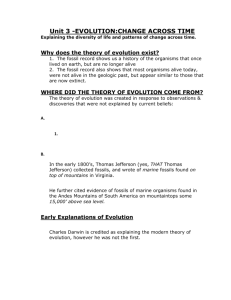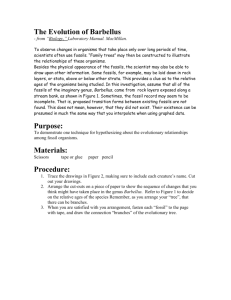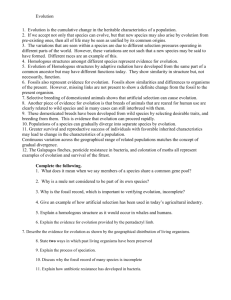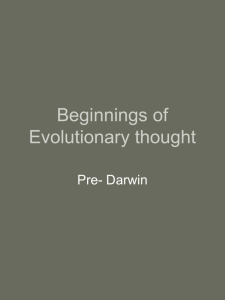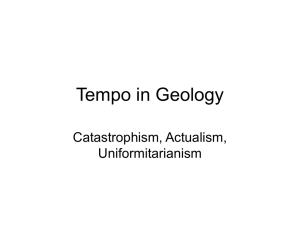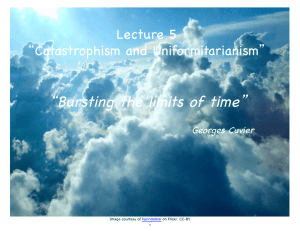Fossils and Earth History
advertisement
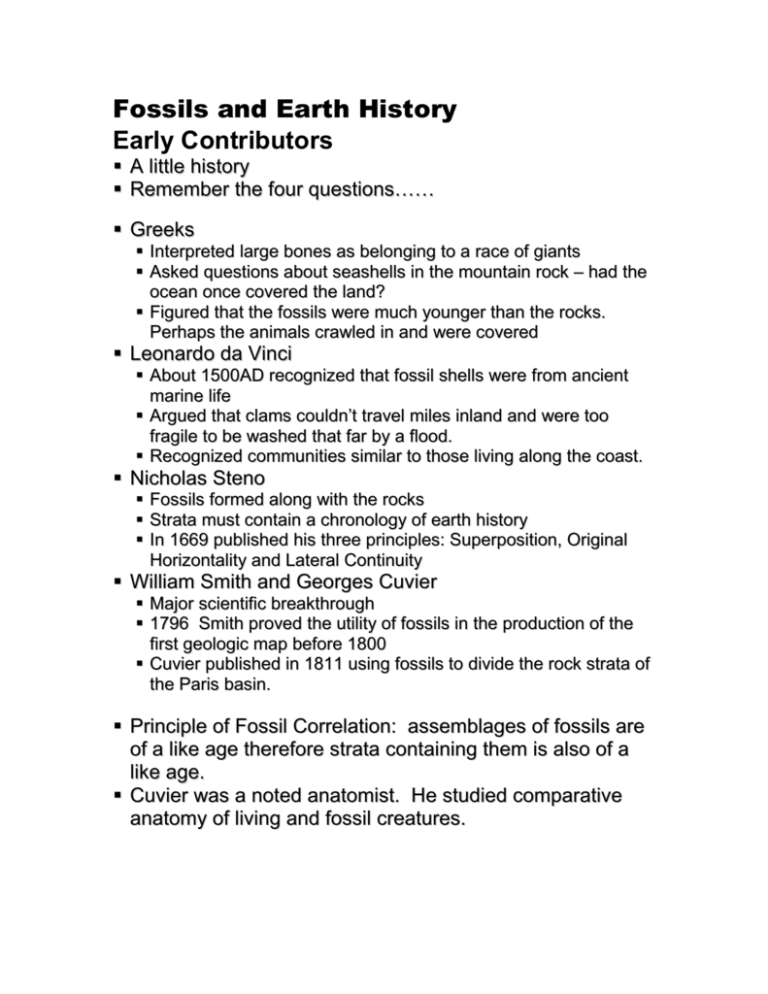
Fossils and Earth History Early Contributors A little history Remember the four questions…… Greeks Interpreted large bones as belonging to a race of giants Asked questions about seashells in the mountain rock – had the ocean once covered the land? Figured that the fossils were much younger than the rocks. Perhaps the animals crawled in and were covered Leonardo da Vinci About 1500AD recognized that fossil shells were from ancient marine life Argued that clams couldn’t travel miles inland and were too fragile to be washed that far by a flood. Recognized communities similar to those living along the coast. Nicholas Steno Fossils formed along with the rocks Strata must contain a chronology of earth history In 1669 published his three principles: Superposition, Original Horizontality and Lateral Continuity William Smith and Georges Cuvier Major scientific breakthrough 1796 Smith proved the utility of fossils in the production of the first geologic map before 1800 Cuvier published in 1811 using fossils to divide the rock strata of the Paris basin. Principle of Fossil Correlation: assemblages of fossils are of a like age therefore strata containing them is also of a l i k e age. Cuvier was a noted anatomist. He studied comparative anatomy of living and fossil creatures. Cuvier explained the changes in fossil assemblages as the result of catastrophic events. This view became known as catastrophism Organic evolution which stated younger organisms descended from older ones was present 100 years before Cuvier Buffon – 1749 published 34 volume work Historie Naturelle Established two fundamental concepts of evolution: adaptation and inheritance Charles Lyell - Published Principles of Geology in 1830 and revised it for the next 45 years Uniformitarianism His work had a great effect on Darwin Erasmus and Charles Darwin – both had an impact on the i dea of ev ol ut i on. Erasmus studied the breeding of cattle and determined that characteristics of the parents were passed on to the offspring. Charles, his grandson, became the “father of modern evolutionary theory” with “Origin of the Species” Carl Linnaeus – mid 1700’s – developed the binomial naming scheme for all living organisms that is still used today. Kingdom Phylum Class Order Family Genus Species Systematics Classifying organisms is known as taxonomy We will use Linnean classifications in this class. This is “classical” taxonomy. It is heirarchical….each level grouped into higher levels Rules for naming organisms: Binomial nomenclature – Genus species, based on Latin Principle of priority – first name proposed in print is the valid name. Once used, even as an invalid synonym they may never be used again Principle of first reviser – when its not clear who published first, the first person to revise the name decides the priority Principle of coordination – the first genus recognized in a family names the family Principle of coordination – the first genus recognized in a family names the family Homonymy – Names already used cannot be used again Type specimens – Specimen for which the new species/genus etc is named. Presumably the best specimen available. Usually kept at a museum or university to be available for study. Briefly about cladistics Based on shared derived characteristics Shows which organisms are more closely related based on structure (4 legs) The relative incompleteness of the fossil record makes this method problematic Evolution Evolution is a fact, not a theory. Evolution is the change in genetic characteristics over time. These changes are passed from one generation to another. Changes to an individual after its birth (acquired characteristics) will not be passed on. Characteristics that prove beneficial – a longer neck to eat leaves higher on the tree – may become dominant because those individuals are better fit to survive in their environment. Evolution takes place over a long period of time – many generations. New characteristics live “side-by-side” with old ones until the old ones gradually die out Structure of the earth: Fossils and plate tectonics


